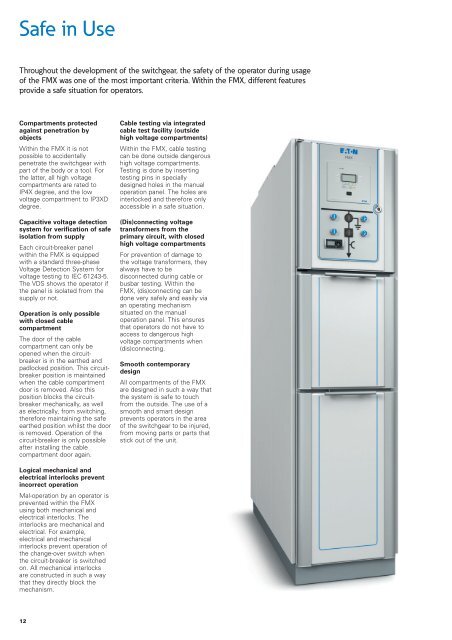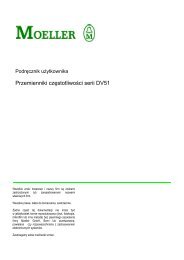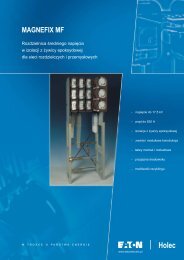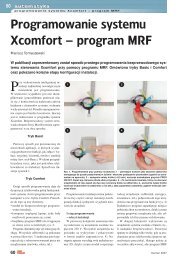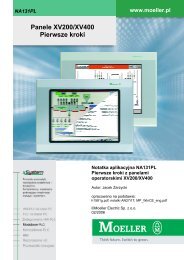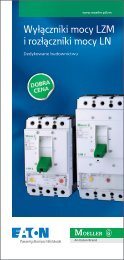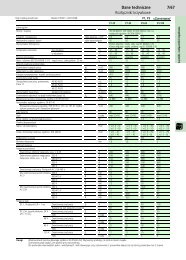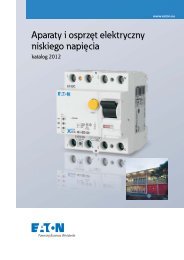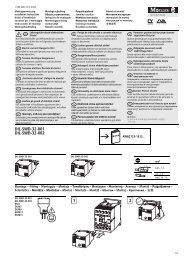6054012BR01 FMX ENG - Moeller
6054012BR01 FMX ENG - Moeller
6054012BR01 FMX ENG - Moeller
You also want an ePaper? Increase the reach of your titles
YUMPU automatically turns print PDFs into web optimized ePapers that Google loves.
Safe in Use<br />
Throughout the development of the switchgear, the safety of the operator during usage<br />
of the <strong>FMX</strong> was one of the most important criteria. Within the <strong>FMX</strong>, different features<br />
provide a safe situation for operators.<br />
Compartments protected<br />
against penetration by<br />
objects<br />
Within the <strong>FMX</strong> it is not<br />
possible to accidentally<br />
penetrate the switchgear with<br />
part of the body or a tool. For<br />
the latter, all high voltage<br />
compartments are rated to<br />
IP4X degree, and the low<br />
voltage compartment to IP3XD<br />
degree.<br />
Capacitive voltage detection<br />
system for verification of safe<br />
isolation from supply<br />
Each circuit-breaker panel<br />
within the <strong>FMX</strong> is equipped<br />
with a standard three-phase<br />
Voltage Detection System for<br />
voltage testing to IEC 61243-5.<br />
The VDS shows the operator if<br />
the panel is isolated from the<br />
supply or not.<br />
Operation is only possible<br />
with closed cable<br />
compartment<br />
The door of the cable<br />
compartment can only be<br />
opened when the circuitbreaker<br />
is in the earthed and<br />
padlocked position. This circuitbreaker<br />
position is maintained<br />
when the cable compartment<br />
door is removed. Also this<br />
position blocks the circuitbreaker<br />
mechanically, as well<br />
as electrically, from switching,<br />
therefore maintaining the safe<br />
earthed position whilst the door<br />
is removed. Operation of the<br />
circuit-breaker is only possible<br />
after installing the cable<br />
compartment door again.<br />
Cable testing via integrated<br />
cable test facility (outside<br />
high voltage compartments)<br />
Within the <strong>FMX</strong>, cable testing<br />
can be done outside dangerous<br />
high voltage compartments.<br />
Testing is done by inserting<br />
testing pins in specially<br />
designed holes in the manual<br />
operation panel. The holes are<br />
interlocked and therefore only<br />
accessible in a safe situation.<br />
(Dis)connecting voltage<br />
transformers from the<br />
primary circuit, with closed<br />
high voltage compartments<br />
For prevention of damage to<br />
the voltage transformers, they<br />
always have to be<br />
disconnected during cable or<br />
busbar testing. Within the<br />
<strong>FMX</strong>, (dis)connecting can be<br />
done very safely and easily via<br />
an operating mechanism<br />
situated on the manual<br />
operation panel. This ensures<br />
that operators do not have to<br />
access to dangerous high<br />
voltage compartments when<br />
(dis)connecting.<br />
Smooth contemporary<br />
design<br />
All compartments of the <strong>FMX</strong><br />
are designed in such a way that<br />
the system is safe to touch<br />
from the outside. The use of a<br />
smooth and smart design<br />
prevents operators in the area<br />
of the switchgear to be injured,<br />
from moving parts or parts that<br />
stick out of the unit.<br />
Logical mechanical and<br />
electrical interlocks prevent<br />
incorrect operation<br />
Mal-operation by an operator is<br />
prevented within the <strong>FMX</strong><br />
using both mechanical and<br />
electrical interlocks. The<br />
interlocks are mechanical and<br />
electrical. For example,<br />
electrical and mechanical<br />
interlocks prevent operation of<br />
the change-over switch when<br />
the circuit-breaker is switched<br />
on. All mechanical interlocks<br />
are constructed in such a way<br />
that they directly block the<br />
mechanism.<br />
12


